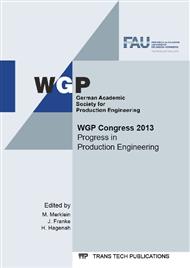p.303
p.311
p.319
p.327
p.335
p.343
p.350
p.359
p.367
Identification of Production Rhythms in Synchronised Assembly Lines by Recording and Evaluating Current Processing Times
Abstract:
Increasing demands on the flexibility of assembly workers lead to numerous times of high exposure rates within one shift. Inflexible processing times in synchronised assembly lines mismatch individual, circadian variable work capacities of operators. As a result, frequent performance peaks due to limited possibilities for individualisation elevate physiological and psychological workloads. The main objective of this paper is an individualisation of assembly system performance requirements. The conceptual framework presented gives the opportunity to specify diurnal assembly system performance requirements by recording and evaluating current processing times. The authors focus on the definition of demands on selecting a workstation, on raw data as well as on time measurement. Subsequently, a methodical approach to record current processing times as well as statistical data processing is presented. Moreover, the application of the presented method leads to an analysis of one representative workstation of a German car manufacturer’s engine assembly. Based on this, the authors define the production rhythm for this workstation and deduce statements on how to adapt the production system to current performance levels preventing physiological and psychological deterioration of assembly employees.
Info:
Periodical:
Pages:
350-358
Citation:
Online since:
September 2013
Keywords:
Price:
Сopyright:
© 2013 Trans Tech Publications Ltd. All Rights Reserved
Share:
Citation:


